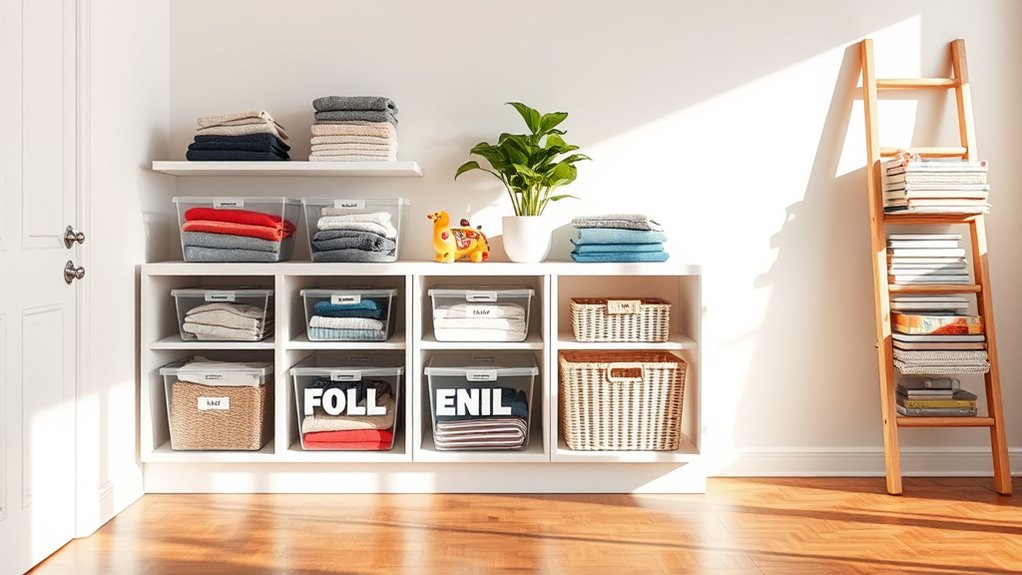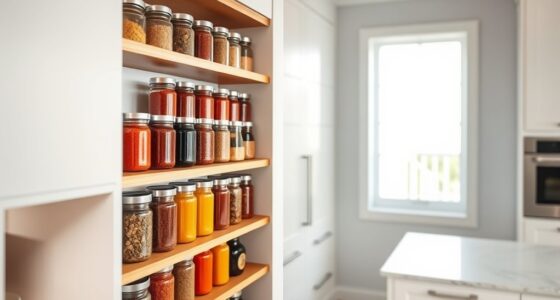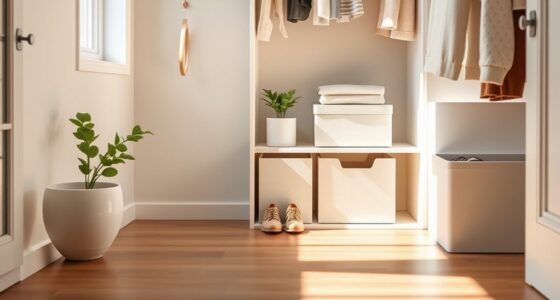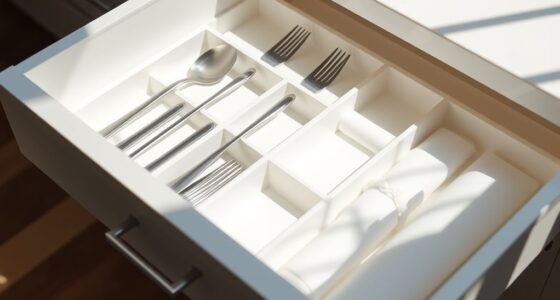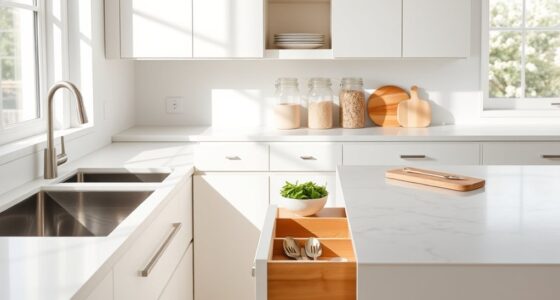When I set out to declutter my home, I found a range of amazing tools that truly helped. The Home Organization Sidekick Journal guides you through each room, while ADHD Organizing offers quick, manageable tasks. Beautifully Organized combines style with function, and House Rules offers accessible design tips. Real Life Organizing makes tidying fun in just 15 minutes a day. Discovering the right strategies was essential for me, and there's so much more to explore.
Key Takeaways
- The Home Organization Sidekick Journal provides structured, phased approaches ideal for overwhelmed individuals needing emotional support and organized tasks.
- ADHD Organizing and Cleaning Solutions focuses on 5-minute tasks, offering manageable strategies especially beneficial for those with ADHD.
- Beautifully Organized combines practical tips with stylish aesthetics, perfect for individuals wanting both organization and appealing home decor.
- Real Life Organizing encourages decluttering in just 15 minutes a day, making it engaging and accessible for families and those feeling overwhelmed.
- Implementing the "one in, one out" rule and dedicating weekly tidying sessions promotes long-term maintenance and accountability in your organization efforts.
The Home Organization Sidekick Journal by Habit Nest
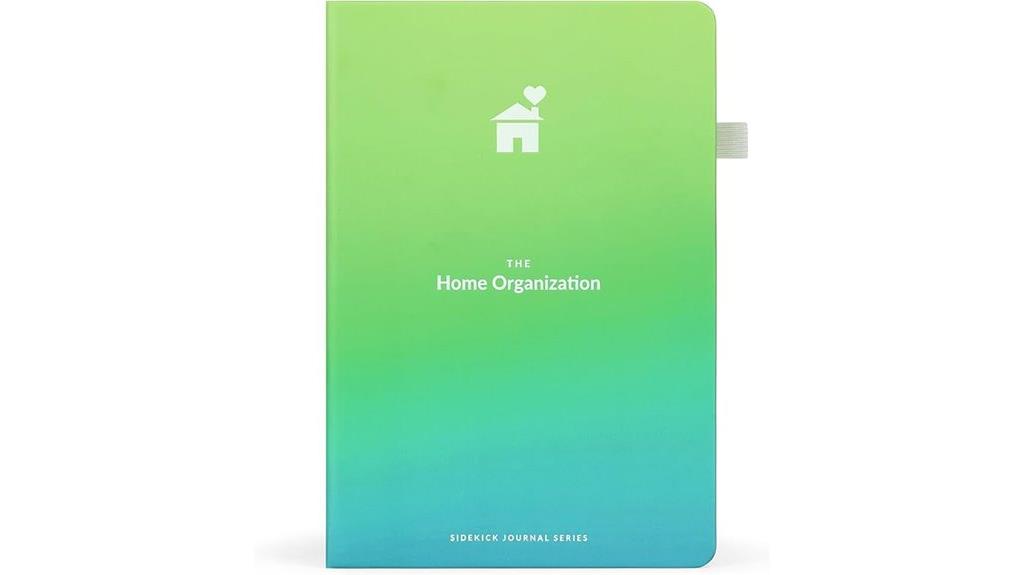
If you're someone who feels overwhelmed by clutter and doesn't know where to start, the Home Organization Sidekick Journal by Habit Nest is the perfect tool for you. This step-by-step guide walks you through eight phases, tackling each room in your home with ease. I found the bite-sized tasks manageable, which helped me avoid feeling overwhelmed. Throughout the process, the journal offers emotional support, encouraging reflection on how I want my space to feel. After organizing just one room, I noticed significant improvements. This journal truly fosters a sense of accountability and progress, making home organization feel achievable and satisfying.
Best For: Individuals feeling overwhelmed by clutter who need a structured approach to home organization.
Pros:
- Provides a step-by-step guide with manageable, bite-sized tasks to reduce overwhelm.
- Offers emotional support and mindset tips, encouraging users to reflect on their space.
- Users report noticeable improvements in their homes after completing just one room.
Cons:
- Lacks specific chapters focused on closets, which are common areas needing organization.
- Some users may find the structured approach too rigid for their personal preferences.
- The journal may require a commitment of time and effort, which could be challenging for busy individuals.
ADHD Organizing and Cleaning Solutions Book

ADHD Organizing and Cleaning Solutions by Caroline Singer stands out as an ideal resource for individuals with ADHD who struggle with clutter and disorganization. This book offers practical, manageable strategies, emphasizing the "5-minute task" concept to make cleaning less intimidating. Singer's compassionate tone reassures readers, addressing feelings of overwhelm while providing actionable steps. The clear layouts and checklists enhance navigation, making it easy to absorb the information. With strategies for time management and maintaining organization, this guide truly transforms the cleaning experience. I highly recommend it for anyone seeking ADHD-friendly solutions to declutter and create a more organized home.
Best For: Individuals with ADHD who struggle with clutter and disorganization and are looking for effective, manageable cleaning strategies.
Pros:
- Provides practical, easy-to-follow strategies that break tasks into manageable "5-minute" increments.
- Features a compassionate tone that addresses feelings of overwhelm and promotes self-compassion.
- Includes useful tools, checklists, and organization tips that cater specifically to ADHD minds.
Cons:
- Some readers may find certain strategies less effective if they require more personalized approaches.
- The book's focus on ADHD may limit its appeal for those without the condition seeking general organizing tips.
- A few readers might prefer more detailed explanations rather than the concise bullet-point format.
Beautifully Organized: A Guide to Function and Style in Your Home
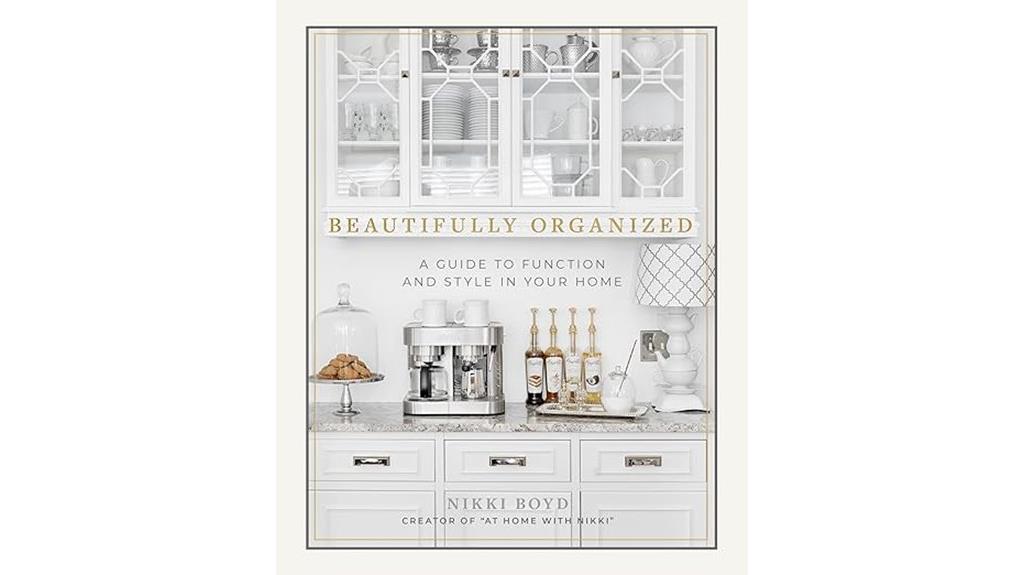
For anyone aiming to create a beautifully organized home while maintaining a sense of style, "Beautifully Organized: A Guide to Function and Style in Your Home" is an invaluable resource. I've found Mrs. Boyd's practical tips truly transformative. From managing school papers to organizing family schedules, her strategies fit seamlessly into everyday life. The book's aesthetic—minimal and stylish—might not resonate with everyone, but the stunning photography and user-friendly layout make it a joy to reference. I've loved connecting with other readers who share their successes, making this journey not just about organization but also about community and inspiration.
Best For: Those seeking practical organization tips and stylish home aesthetics to transform their living spaces.
Pros:
- Provides practical and easily applicable organization strategies for various aspects of home life.
- Features beautiful photography and a minimalistic design that enhances the reading experience.
- Fosters a sense of community among readers, encouraging shared experiences and inspiration.
Cons:
- The all-white aesthetic may feel cold or lack warmth for some readers.
- Some organizational concepts may be similar to those found in other resources, reducing novelty.
- The focus on style might not appeal to individuals who prioritize functionality over aesthetics.
House Rules: How to Decorate for Every Home, Style, and Budget

"House Rules: How to Decorate for Every Home, Style, and Budget" is a perfect choice for anyone looking to transform their space without feeling overwhelmed. Myquillyn Smith's beautifully illustrated guide offers practical advice that's both accessible and relatable. Each chapter focuses on a single design rule, accompanied by stunning photos, making it easy to digest. I found it an inspiring gift for friends and family, appealing to all ages. The friendly tone encourages you to embrace your style, helping you articulate your preferences and repurpose items creatively. This book truly empowers you to craft your ideal living space effortlessly.
Best For: Anyone looking to enhance their home decor effortlessly, including brides, new homeowners, and design enthusiasts of all ages.
Pros:
- Encourages creativity and personalization in home decor with practical, easy-to-follow advice.
- Visually appealing with beautiful photographs that inspire and illustrate design concepts.
- Engaging writing style creates a connection with readers, making the decorating process feel approachable.
Cons:
- Some readers may find the design rules too simplistic or basic for advanced decorating needs.
- Limited depth on specific topics, as each chapter focuses on a single rule rather than comprehensive coverage.
- May not appeal to those who prefer a more formal or technical approach to interior design.
Real Life Organizing: Clean and Clutter-Free in 15 Minutes a Day (Clutterbug)

If you've ever felt overwhelmed by clutter and don't know where to start, "Real Life Organizing: Clean and Clutter-Free in 15 Minutes a Day" by Clutterbug might just be the solution you need. This book transformed my approach to tidying up, showing me that small, manageable goals can lead to significant changes. The clutter personality test helped me understand why past methods failed, making strategies more effective. I even involved my family, turning decluttering into a fun team activity. Cassandra Aarssen's engaging style made the process enjoyable, and the beautiful images kept me inspired. It's a must-read for anyone seeking organization.
Best For: Individuals seeking practical, accessible strategies for decluttering and organizing their spaces, particularly those feeling overwhelmed by clutter.
Pros:
- Engaging and conversational writing style that makes the organizing process enjoyable.
- Provides small, manageable goals that are easy to follow, even for children and families.
- Includes a clutter personality test to help tailor strategies to individual organizing styles.
Cons:
- Currently available only in English, limiting accessibility for non-English speakers.
- May not provide in-depth solutions for more complex organizing challenges.
- Some readers might find the techniques too simplistic if they have advanced organizing experience.
The Joy of Less: A Minimalist Guide to Declutter, Organize, and Simplify

Minimalism can transform your living space into a sanctuary of peace and clarity, especially for anyone feeling overwhelmed by clutter. In "The Joy of Less," Francine Jay offers an invigorating perspective on decluttering and organizing. She encourages us to reconsider our relationship with our possessions, asking whether they truly serve our lives. I found her practical strategies, like the room-by-room approach and the "one in, one out" rule, incredibly effective. By embracing minimalism, I've experienced less stress and more appreciation for what I own. Letting go has opened up space for meaningful experiences, making my home a haven rather than a burden.
Best For: Individuals seeking to declutter their lives and embrace a minimalist lifestyle for a more organized and peaceful home environment.
Pros:
- Engaging Writing: Francine Jay's humorous and relatable writing style makes the concepts of minimalism accessible to everyone.
- Practical Strategies: Provides actionable tips, such as room-by-room decluttering and the "one in, one out" rule, making it easy to implement changes.
- Personal Growth: Encourages introspection about one's relationship with possessions, leading to greater appreciation for meaningful experiences.
Cons:
- Time-Consuming: The decluttering process can be time-intensive, requiring commitment and effort from the reader.
- Emotional Challenge: Letting go of sentimental items may be difficult for some individuals, potentially causing emotional distress.
- Not One-Size-Fits-All: The minimalist approach may not resonate with everyone, as personal definitions of "enough" can vary widely.
Decluttering at the Speed of Life

For anyone feeling overwhelmed by clutter but unsure where to start, "Decluttering at the Speed of Life" offers a revitalizing, approachable solution. Dana K. White's humorous style resonates with me, making her insights feel relatable. She emphasizes taking small steps, reminding us that even minimal progress counts. I love her room-by-room approach, which simplifies the decluttering journey. Plus, she acknowledges our emotional attachments and guilt, providing a compassionate framework for decision-making. Since applying her practical strategies, I've seen real changes in my home and mindset. This book truly inspires me to embrace a clutter-free life at my own pace.
Best For: Individuals overwhelmed by clutter who seek practical, relatable strategies to simplify their decluttering process at their own pace.
Pros:
- Humorous and engaging writing style makes the content relatable and enjoyable to read.
- Focus on small steps ensures that progress is achievable without feeling overwhelming.
- Compassionate approach to emotional attachments helps alleviate guilt and internal conflicts associated with decluttering.
Cons:
- Some readers may find the strategies too basic if they are looking for more in-depth explorations of consumerism or emotional clutter.
- The room-by-room approach might not suit everyone's organizational style or preferences.
- Limited focus on long-term maintenance of a clutter-free space could leave some readers wanting more guidance.
Decluttering Your Home Workbook

The "Decluttering Your Home In A Year Or Less! Workbook" is a fantastic resource that helps you tackle clutter systematically. It's packed with exercises and self-reflection sections that make the process not only effective but enjoyable. I found the written inventory technique particularly helpful; it forces you to confront what you truly need. Many readers, like me, have shared their personal decluttering journeys, and I recommend gifting this workbook to anyone struggling with organization. While some critiques mention its informal language, the workbook remains a valuable tool for achieving a perfectly organized space. Let's plunge into it and get started!
Best For: Individuals seeking a structured and motivational approach to decluttering their homes, especially those who enjoy self-reflection and personal anecdotes.
Pros:
- Step-by-step techniques provide clear guidance on how to tackle clutter effectively.
- Personal anecdotes from readers create a sense of community and shared experiences.
- Exercises like written inventories help individuals confront their possessions and prioritize what truly matters.
Cons:
- Informal language may not resonate with all audiences, particularly seniors who might find it off-putting.
- Some readers find the emphasis on self-reflection and detailed listings impractical for their lifestyles.
- There is confusion over accessing online resources that were promised in the workbook.
Zero Waste Home: The Ultimate Guide to Reducing Waste
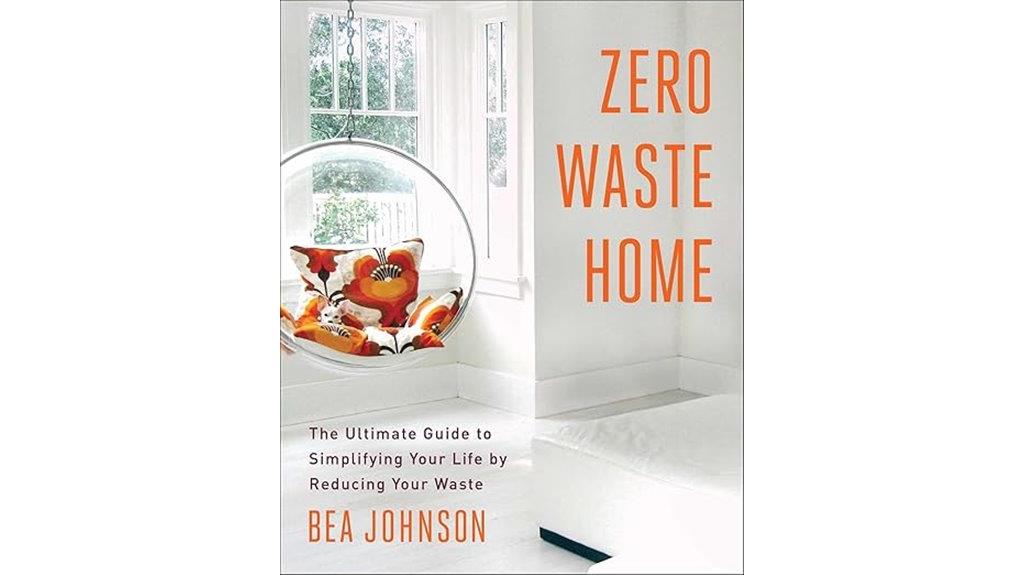
Embracing a zero waste lifestyle isn't just for eco-warriors; it's perfect for anyone looking to streamline their home and life. I found Bea Johnson's book, "Zero Waste Home," to be a game-changer. Her practical tips, like shopping sustainably and eliminating disposables, inspired me to rethink my habits. Bringing my own containers to restaurants not only reduces waste but encourages others, too. The resources she provides make the shift accessible, allowing me to take small yet impactful steps. Adopting these practices has greatly cut down my trash output, proving that a fulfilling life can be both stylish and sustainable.
Best For: Individuals and families looking to adopt a sustainable lifestyle while simplifying their home and reducing waste.
Pros:
- Actionable Strategies: Provides practical tips that are easy to implement in daily life.
- Inspirational Message: Encourages readers to reflect on their consumption habits and make positive changes.
- Comprehensive Resources: Offers a wealth of resources for recycling, bulk shopping, and reducing waste.
Cons:
- Familiar Content: Some readers may find the information presented to be familiar or repetitive.
- Not All Tips Are New: Critics argue that many concepts are already well-known in sustainability circles.
- Requires Lifestyle Changes: Transitioning to a zero waste lifestyle can be challenging and may require significant adjustments.
The Sentimental Persons Guide to Decluttering

If you find it difficult to part with sentimental items, "Decluttering Tools for an Organized Home" is exactly what you need. This guide motivates us sentimental folks to face our clutter head-on, allowing us to downsize without guilt. By grouping like items together, I've found it easier to manage my inventory and make progress—donating boxes of books was liberating! The author helps us confront emotional attachments, reminding us that gifts shouldn't feel like burdens. With relatable stories and straightforward advice, this book truly resonates with anyone struggling to declutter while maneuvering their feelings about belongings.
Best For: Sentimental individuals who struggle with clutter and seek motivation to downsize their possessions without guilt.
Pros:
- Motivational: Provides encouragement for those facing emotional attachments to their belongings.
- Practical Strategies: Offers effective methods for organizing and prioritizing items, making the decluttering process manageable.
- Relatable Stories: Shares personal experiences that resonate with readers, fostering a sense of understanding and community.
Cons:
- Basic Content: Some readers may find the advice too simplistic if they are already familiar with decluttering concepts.
- Emotional Strain: Addressing emotional attachments can be challenging and may require additional support for some individuals.
- Limited Scope: Focuses primarily on sentimental items, which may not fully address other types of clutter.
Doable Decluttering Workbook: Proven Methods to Organize Your Home
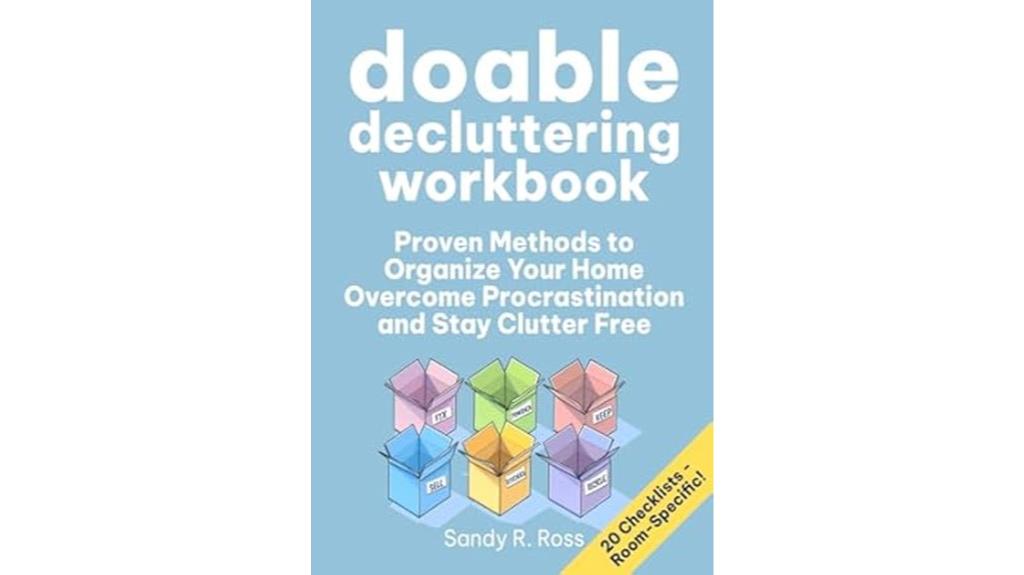
For anyone feeling overwhelmed by clutter and struggling to find a starting point, the "Doable Decluttering Workbook" is an invaluable resource. It guides you through a step-by-step process that tackles procrastination and helps maintain a clutter-free home. With practical strategies like the 6-Box System and room-by-room checklists, decluttering becomes manageable. The workbook also addresses emotional ties to belongings, encouraging a compassionate approach. Readers share success stories, noting how the supportive prompts made a difference in their spaces. While not every tip will resonate with everyone, its flexibility lets you adapt strategies to fit your unique needs.
Best For: Individuals feeling overwhelmed by clutter who need a structured approach to decluttering their home.
Pros:
- Offers a step-by-step process that helps combat procrastination.
- Provides practical strategies like the 6-Box System and room-by-room checklists for effective decluttering.
- Encourages a compassionate approach by addressing emotional ties to belongings.
Cons:
- Some tips may not resonate with everyone, limiting effectiveness for certain individuals.
- Requires personal adaptation, which may be challenging for those who prefer a more structured approach.
- The workbook may not address all specific clutter issues, necessitating additional resources for comprehensive solutions.
The Organizing Recipe Book: 70 Simple Projects
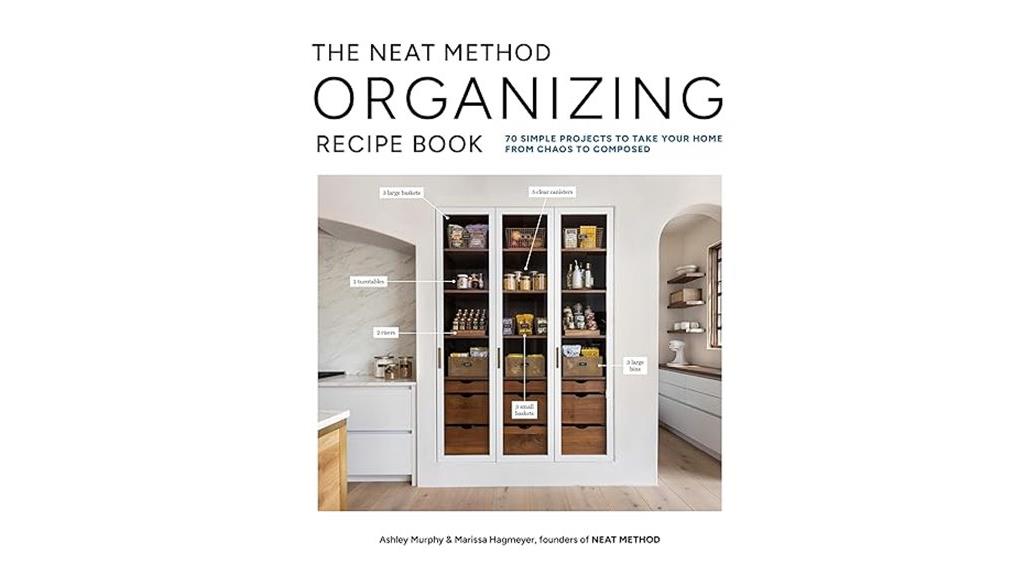
The Organizing Recipe Book: 70 Simple Projects stands out as an essential resource for busy parents and professionals endeavoring to create a calm and organized home. This beautifully structured guide provides step-by-step instructions that make organization manageable for everyone, regardless of skill level. With practical tips and "pro tips" sprinkled throughout, I found it easy to tackle various spaces in my home, from small nooks to larger areas. Plus, the stunning photography inspires me to envision my own organized spaces. Whether for personal use or as a thoughtful gift, this book truly helps transform your environment into a serene sanctuary.
Best For: Busy parents and professionals looking to create a serene and organized home environment.
Pros:
- Provides step-by-step instructions that are easy to follow, making organization achievable for all skill levels.
- Includes practical tips and "pro tips" throughout, enhancing the overall guidance for effective organization.
- Features stunning photography that not only inspires but also serves as a beautiful coffee table book.
Cons:
- Some readers have expressed disappointment with certain aspects, indicating mixed reviews.
- The focus on long-term organization solutions may not address immediate clutter issues for some users.
- Not all projects may suit every individual's personal style or space needs.
Declutter Like a Mother: A Guilt-Free Home Transformation Guide
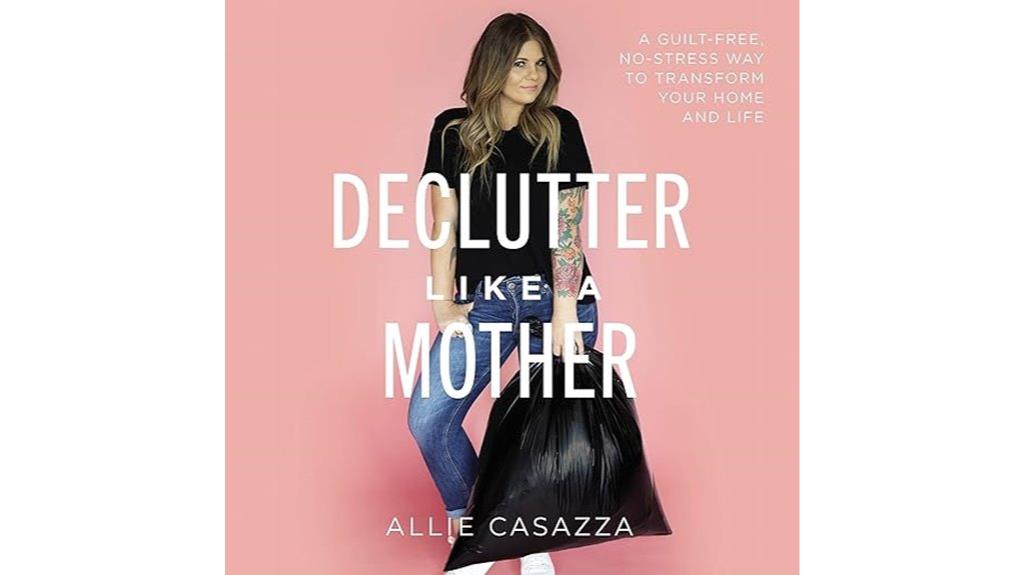
Women looking to reclaim their homes from chaos will find "Declutter Like a Mother" an invaluable resource. Allie Casazza offers a personalized approach, encouraging us to contemplate our lifestyles and the purpose of each room. She guides us through actionable questions to evaluate our belongings, emphasizing that clutter consumes not just space but also time. Allie helps us confront the fears and guilt tied to letting go, fostering a mindset shift towards intentional decision-making. With her relatable tone and practical strategies, I felt empowered to create a home that truly reflects my values, transforming my space into a sanctuary.
Best For: Women seeking to reclaim their homes from chaos and create a clutter-free environment that reflects their values and lifestyles.
Pros:
- Provides actionable strategies and personalized guidance for effective decluttering.
- Encourages a mindset shift to confront emotional ties to belongings, promoting personal growth.
- Fosters a supportive community among women, creating a sense of empowerment and shared experience.
Cons:
- May require significant time and emotional investment to fully engage with the decluttering process.
- Some readers might find the approach too subjective if they prefer more structured methods.
- Emotional challenges related to letting go of possessions may be difficult for some individuals to navigate.
Uncluttered Living: Transform Your Life Through Decluttering and Organizing
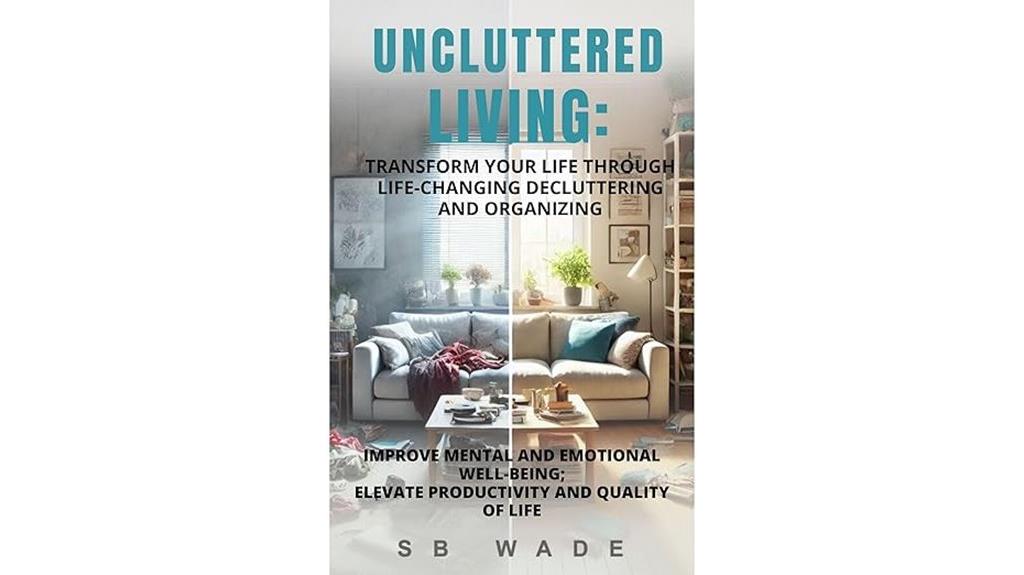
If you've ever felt overwhelmed by the chaos in your home, decluttering tools can be a game changer. I found that letting go of unnecessary possessions not only cleared my physical space but also lifted a heavy emotional burden. By following structured steps and using checklists, I tackled clutter one small area at a time, which kept me motivated. The process helped me manage not just physical items but also emotional and digital clutter. Plus, connecting with others on this journey made it more engaging. Embracing uncluttered living truly transformed my life for the better.
Best For: Individuals seeking to improve their mental well-being and create a more organized living space through decluttering and organizing techniques.
Pros:
- Structured approach with step-by-step guidance and checklists makes the decluttering process manageable and motivating.
- Addresses multiple forms of clutter (physical, emotional, and digital), providing a comprehensive strategy for overall well-being.
- Community support enhances motivation and accountability, making the decluttering journey engaging and sustainable.
Cons:
- Some readers may find the process overwhelming if they have a significant amount of clutter to tackle.
- Emotional attachment to possessions can make it difficult for individuals to let go, potentially leading to frustration.
- The need for consistent effort and commitment may not suit everyone's lifestyle or preferences.
Factors to Consider When Choosing The Decluttering Tools for a Perfect Home

When I think about choosing the right decluttering tools, I realize it's crucial to reflect on how they fit my personal needs and emotional ties to my belongings. I also find that practicality and room-specific solutions play a huge role in maintaining an organized space. Finally, having a long-term maintenance plan guarantees I won't just end up back where I started.
Personalization of Strategies
Choosing the right decluttering tools can transform how I approach organizing my home. Personalizing my strategies is key, as my emotional attachments and lifestyle shape my relationship with my possessions. I find that tailoring my methods to specific challenges, like sentimental items or digital clutter, boosts my motivation and effectiveness. Using systems like the "6-Box System" helps me categorize my belongings based on what truly matters to me, making decisions about what to keep or discard easier. Incorporating self-reflection allows me to assess the utility and emotional value of each item, leading to satisfying choices. I also emphasize small, achievable tasks, which suit my pace and foster long-term organizational habits that stick.
Emotional Considerations in Decluttering
As I explore the emotional considerations in decluttering, I recognize how powerful our attachments to possessions can be. These emotional ties often create barriers, leading to guilt or anxiety when deciding to let go of items. It's crucial to address these feelings, as they reveal our motivations for clutter and help create a compassionate decluttering process. Sentimental items, like gifts or inherited possessions, require special attention since they stir up memories that complicate decision-making. Engaging in self-reflection allows me to acknowledge the emotional weight of my belongings, empowering me to make intentional choices. By prioritizing my well-being over material possessions, I can alleviate the mental burden of clutter, fostering a more serene living environment.
Practicality of Tools
Selecting the right decluttering tools can greatly impact your organizing journey, especially if you consider your unique needs and preferences. I've found that prioritizing tools with clear, actionable steps helps break tasks into manageable portions, preventing overwhelm. Tools that include checklists or tracking methods boost my motivation and accountability, making it easier to stay on track. I also look for customizable strategies that adapt to my lifestyle and specific clutter challenges. It's essential for practical tools to address emotional aspects as well, providing compassionate guidance for managing feelings of guilt or attachment. Finally, I prefer user-friendly formats with visually appealing layouts and concise information to promote ongoing engagement throughout the decluttering process.
Room-Specific Solutions
While practical tools set a strong foundation for decluttering, tailoring your approach to specific rooms can elevate your organizing efforts even further. In the kitchen, I focus on categories like cookware, utensils, and pantry items to guarantee every area's addressed. For my living room, I organize books, electronics, and decorative pieces while using storage solutions that look good and work well. In the bedroom, I tackle clothing and accessories, employing seasonal rotations and donation bins for unused items. Bathrooms benefit from grouping toiletries and personal care products, which helps me spot duplicates and expired items. Finally, my home office prioritizes paperwork and supplies, utilizing filing systems and digital tools to keep clutter at bay and boost productivity.
Long-Term Maintenance Plans
To maintain an organized home, I've learned that implementing a long-term maintenance plan is essential. I dedicate 15 minutes each week to tidy up specific areas, which makes a big difference. One useful strategy is the "one in, one out" rule; for every new item I buy, I remove an existing one. This keeps clutter at bay. I also use checklists to remind myself of areas needing attention, helping me stay on track. Setting specific goals and deadlines for tasks holds me accountable and encourages consistent upkeep. Finally, involving my family in the process fosters shared responsibility, making it easier to sustain an organized environment together. With these strategies, I can enjoy a clutter-free space long-term!
Frequently Asked Questions
How Can I Maintain Organization After Decluttering My Home?
Maintaining organization after decluttering can feel challenging, but I've found a few strategies that work. I set aside time each week to reassess my spaces and tackle any clutter that's crept back in. I also designate specific spots for everything, making it easy to return items after use. Finally, I remind myself to let go of things I no longer need, which helps keep my home feeling organized and stress-free.
Can Decluttering Tools Help With Emotional Attachment to Items?
I've found that decluttering tools can really help with emotional attachment to items. When I use boxes or labels, it makes the process more tangible and less overwhelming. I focus on what truly matters, which helps me let go of things that no longer serve me. It's like having a physical reminder of my priorities. Each time I declutter, I feel lighter and more in control of my space and emotions.
What Are the Best Storage Solutions for Small Spaces?
When I tackle storage solutions for small spaces, I find multi-functional furniture incredibly helpful. For instance, I use ottomans with hidden compartments to store blankets and books. Shelving units that reach up to the ceiling allow me to maximize vertical space, while under-bed storage bins keep items out of sight yet accessible. I've also started using decorative baskets to organize smaller items, which adds style and keeps everything tidy.
How Often Should I Reassess My Decluttering Progress?
Like a gardener tending to their plants, I find it's vital to regularly reassess my decluttering progress. I usually do this every season or after a significant life change. This way, I can make sure I'm not holding onto items that no longer serve me. It keeps my space fresh and my mind clear. Remember, it's a journey, not a race, so I give myself grace as I navigate my decluttering path.
Are There Apps Available to Assist With Decluttering?
Absolutely, there are several apps that can really help with decluttering! I've found tools like Clutterfree and Sortly to be super useful. They allow me to track my items, set decluttering goals, and even categorize everything for easier organization. Plus, using these apps makes the whole process feel more manageable and enjoyable. If you haven't tried them yet, I highly recommend giving them a shot to streamline your decluttering journey!
Conclusion
In the journey to a perfectly organized home, the right decluttering tools can make all the difference. Imagine this: you spend a Saturday afternoon using "Declutter Like a Mother," transforming your chaotic living room into a serene space. You finally find a home for that stack of magazines, and with every item you put in its place, you feel lighter and more in control. Embrace these tools, and soon, your organized haven will be just a few decluttering sessions away!
